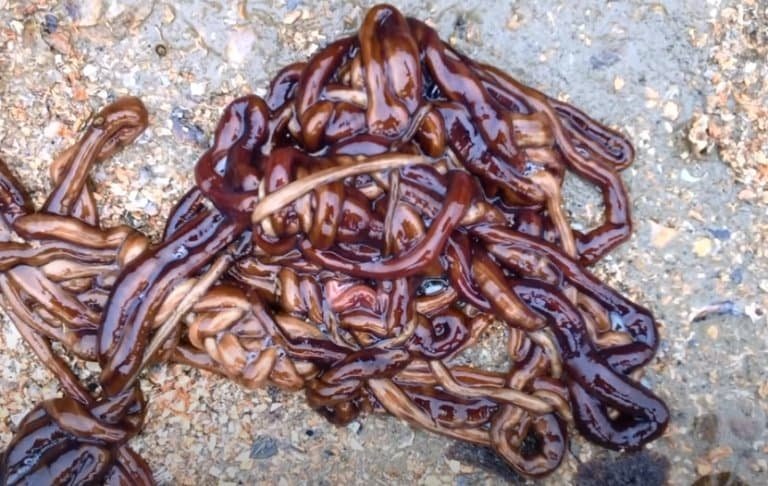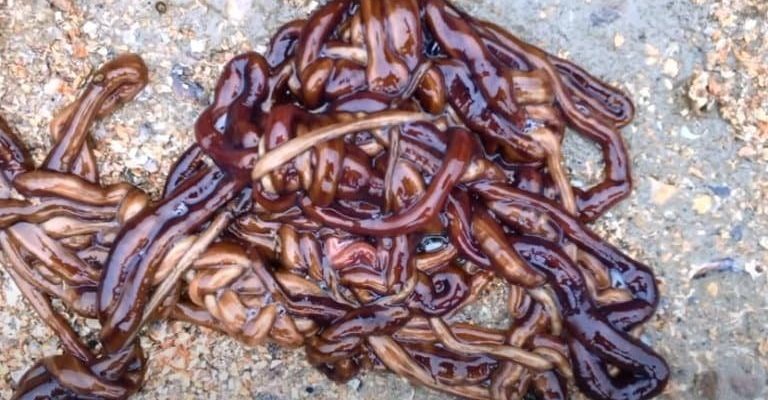
Let’s dive into what makes bootlace worms special and uncover whether they’re friend or foe in the animal kingdom. Picture them as the untamed, mysterious relatives of your average earthworm, living in the depths of the ocean and even in freshwater environments. But do these fascinating creatures pose a threat to fish or wildlife?
What Exactly Are Bootlace Worms?
Bootlace worms belong to the **Hirudinea** class, which means they’re related to leeches. They’re mostly found in the waters of Europe, particularly in coastal areas, lurking among seagrasses and mudflats. These worms can be quite striking in appearance, often displaying vibrant colors, which can range from brown to a stunning blue.
One thing you might find interesting about them is their unique way of moving: they glide along surfaces using a wave-like motion. Imagine a snake slithering, but in a more fluid and graceful manner. Bootlace worms are known for their incredible lengths, and some can achieve sizes that make them look like a snake in the water!
Life Cycle and Habitat of Bootlace Worms
Bootlace worms thrive in **brackish** waters, a mix of salt and freshwater. This environment supports their growth and life cycle. They tend to prefer areas with plenty of organic matter to feed on, like detritus (tiny bits of decomposing organic material).
Their life cycle is fascinating as well. Bootlace worms can reproduce both sexually and asexually. When they breed, they release a lot of eggs, ensuring their survival despite environmental changes. This ability to adapt makes them quite resilient creatures. Imagine a plant that can go dormant during drought and bloom in the rain; bootlace worms can do something similar in their aquatic world.
Diet: What Do Bootlace Worms Eat?
You might be curious about what bootlace worms feast on. Well, they have a pretty varied diet. These worms are primarily **scavengers**, consuming detritus, which means they help break down organic material in their environment. This role is crucial for maintaining balance in the ecosystem.
Bootlace worms also don’t shy away from munching on small organisms, including tiny fish eggs and larvae. This is where concerns about their threat level start to bubble up. If they’re nibbling on baby fish, that could potentially affect fish populations. However, research suggests that they play a more beneficial role than harmful in their ecosystems, supporting nutrient cycling rather than decimating fish populations.
Do Bootlace Worms Pose a Direct Threat to Fish?
Now, let’s address the elephant in the room: do bootlace worms pose a threat to fish? Honestly, while they do eat fish eggs and larvae, they typically aren’t a major risk to adult fish. Their primary role is more beneficial, breaking down organic matter rather than becoming a primary predator.
Think of bootlace worms as a necessary part of the ocean’s cleanup crew—removing waste and helping ecosystems thrive. If fish populations are healthy and diverse, the impact of bootlace worms on fish would be negligible. In fact, they might even play a role in supporting fish populations by maintaining a clean environment for them to thrive in.
Bootlace Worms and Other Wildlife
Aside from fish, bootlace worms can also interact with other wildlife. For example, they can become food for larger predators, such as crabs and fish, completing their role in the food chain. Their presence can indicate a healthy ecosystem, making them important for biodiversity.
However, if their populations grow unchecked due to environmental changes, they could disrupt local habitats. As with many species, balance is key. When everything’s in check—water quality, available food, and breeding populations—bootlace worms mainly contribute to the ecosystem rather than threaten it.
Common Misconceptions About Bootlace Worms
You might have heard myths about bootlace worms being dangerous or even poisonous. Here’s the thing: while they can look intimidating due to their size and unique appearance, they don’t actually pose a threat to humans or pets. Their bite is not venomous, and they primarily feed on smaller organisms.
These misconceptions often arise from their resemblance to leeches. Unlike leeches, which are notorious for attaching to larger animals, bootlace worms tend to keep to themselves. They aren’t out for blood, so to speak. Instead, they play a vital role in marine ecosystems, promoting overall health and balance.
So, do bootlace worms pose any threat to fish or wildlife? The answer is more nuanced than a simple yes or no. While they do consume fish eggs and small organisms, their overall impact is more beneficial than harmful. Think of them as a part of the ecosystem’s intricate web, providing essential services and supporting the health of their surroundings.
Ultimately, bootlace worms play a crucial role in keeping our waterways clean and balanced. As fascinating as they are, they don’t represent a significant threat to fish or wildlife. Like many creatures in nature, they are best admired for their unique contributions to biodiversity and ecosystem health. Next time you hear about bootlace worms, you can confidently say they’re more of a friend than a foe in the grand scheme of things.

